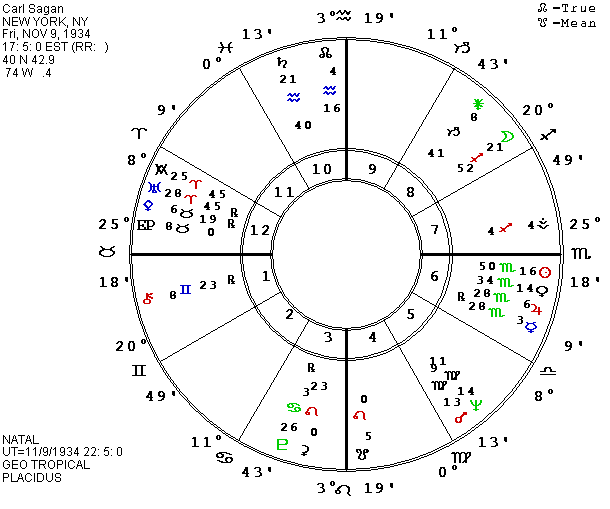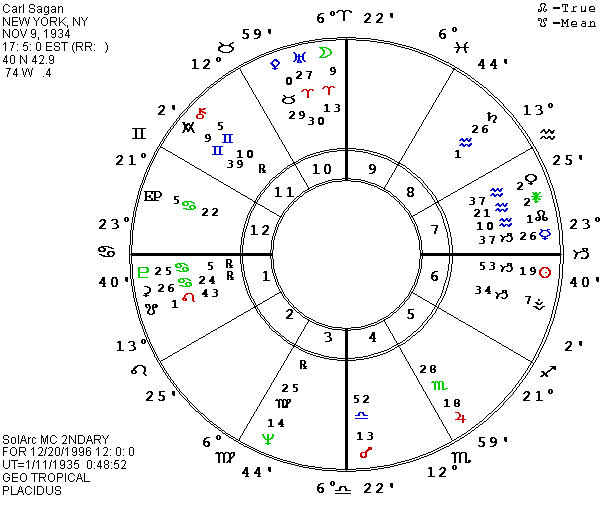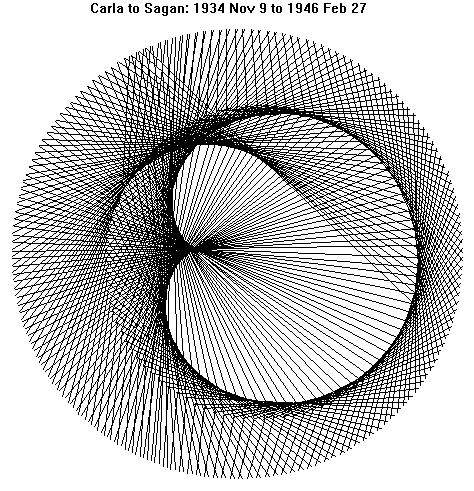Carl Sagan Departs
Zip Dobyns
As I was finishing the article on two possible cases of alien abduction, the report came that Carl Sagan had died in a Seattle hospital. He had been ill with a rare bone-marrow disease for two years, but finally died of pneumonia on December 20, 1996. My information is that Sagan was born in New York on November 9, 1934 at 5:05 P.M. He was a famous astronomer, especially noted for popularizing the subject among the general public, including the development of special equipment designed to listen for possible radio signals from extra-terrestrial life. His series called Cosmos on PBS may have had a record number of viewers, and some of his books were best-sellers. But he was also an agnostic, clinging to the materialistic belief system of modern, western science. He commented that physical death was the end of the person, and his last book, The Demon-Haunted World, attacked the beliefs in psychic experiences which have been reported everywhere in the world for as long as we have records.

Sagan’s struggle with issues of faith is dramatically shown in his chart, and emphasized at his death. In fact, I think that his lack of faith in a higher power contributed to his early death at the age of 62. Any part of our nature which is being denied will become a problem. The astrological keys to faith include Jupiter and factors in its sign and in or ruling its natural house for our conscious belief system. Neptune and factors in its sign and in or ruling its natural house describe our subconscious faith, our potential for experiencing a connection to the Whole as a participating part of the Absolute. Chiron can be a key to either of these types of faith and Jupiter remains a co-ruler of Pisces and the twelfth house. Earth in any form but especially letters six and ten are the most skeptical parts of life, wanting physical evidence for theories.
Sagan’s chart shows him torn between those conflicting inclinations. His Mars conjunct Neptune and Aries in the twelfth house showed an identification with letter twelve—his potential to be a mystic. Another key to identity, Mercury ruling the first house Gemini, was conjunct Jupiter, and Chiron was in the first house. But Mars and Neptune were in Virgo, his East Point and Ascendant were in Taurus, plus most of Taurus was in the twelfth house, Mercury and Jupiter were in the Virgo house along with Venus, ruler of the Ascendant and ruler of part of the twelfth house. Capricorn was in the ninth house, and its ruler, Saturn, was in the tenth house. The repeated theme includes planetary keys to faith in earth signs or houses plus earth signs or their rulers in the houses of faith, so Sagan was identified with and driven to find the Absolute but to focus on the material world. When we are identified with letters nine and/or twelve, we can think we are or ought to be God. If we lack faith in a higher power, we may take on an enormous personal burden and be subject to anxiety or depression. The earth element shows where we feel we have to handle things ourselves, to cope with the material world. With their focus on looking for what is wrong in order to correct things and do them right, letters six and ten are especially in danger of dwelling on the dark side of life. Those who have faith in something beyond themselves or their fellow humans can do their best but then let go, sustained by the trust and hope that everything will be OK in the end.
As I write repeatedly, the different sides of life symbolized by astrology are inherently in conflict but they are also natural antidotes to the excesses of each other. We need them all! With excessive faith (gullibility) at the expense of practicality, we may be unable to survive in the material world. A total lack of faith in anything beyond personal rights and power produces sociopaths. If our faith is only in material objects or in other humans, we turn them into idols and are either disillusioned when they let us down or we lose them to force us to find a bigger god. Letter nine represents the search for and faith in ultimate truth, which is the driving force in “true” scientists. But if our basic premises, our definition of truth and reality, are too limited by materialistic beliefs, we are unable to acknowledge the reality of non-material experiences. They are dismissed as imagination, coincidence, fraud, deliberate deception or self-deception, etc. Sagan maintained his identification as a materialistic scientist, but did so at the cost of what could have been a healing faith in an infinitely larger reality.
Philosopher Paul Kurtz founded the “Committee for the Scientific Investigation of Claims of the Paranormal (CSICOP), supposedly to research the claims of non-material reality, but in practice to debunk them. As I wrote in the Virgo 1995 issue of The Mutable Dilemma, Kurtz is a professor at a New York University in Buffalo, and he was formerly the editor of the Journal of the American Humanists, but they requested his resignation when he became too vigorous in his attacks on all religion. He then founded his own journal called The Skeptical Inquirer, which continues to attack all beliefs in non-material reality as superstition and to publicize their own supposedly scientific materialism as widely as possible in the media. Kurtz led the attack on astrology in 1975 when some hundred-plus “scientists” were persuaded to sign a statement that it was nonsense. Most astronomers are officially materialists, if only to maintain their standing in science. In one of the last collections of newly named asteroids which are discovered and named by astronomers, one was named in honor of Kurtz and one was called Skepticus as a Greek version of the name of his society
CSICOP has been growing in numbers and financial strength and recently celebrated an anniversary by opening their first official Center with their own building in Buffalo. Branch chapters or affiliates exist in other states, including a very active group in Los Angeles who have regular meetings at Caltech and who publish their own sizable journal. I am watching with fascination as the adherents of two opposing belief systems mobilize for the coming showdown, which may come during this period of Uranus transiting through its own sign. Some of the articles in the journal published by the L.A. group are constructive criticisms of some of the excesses of the psychic fringe. This group is not as hostile and dogmatic (and dishonest in my opinion) as the close associates of Kurtz. The latter include the “Amazing Randi,” a professional magician who is about as trustworthy as his magic tricks are genuine. A “showdown” does not mean that all the members of either side will be convinced, but increasing numbers of “genuine” scientists are recognizing the validity of psychic phenomena and a meaningful world in which ultimate reality is consciousness (mostly not self-conscious) rather than meaningless, random physical energy. Materialism is a belief-system and “true believers” are not open to conflicting evidence or it would have been as dead as the dodo long ago.
This long digression about Kurtz and his fellow materialists in an article about Carl Sagan is included to explain the relevance of the new asteroids in Sagan’s chart. We also have his own “name” asteroids: Carla as a feminized version of Carl, and Sagan which was discovered in 1982 and named in his honor. When its position is calculated for his birth, nearly 50 years before it was discovered and named, Sagan was conjunct his N Saturn within 3 minutes of longitude. His tenth house Saturn was, of course, a primary significator of his career and thus the reason for his being honored by an asteroid bearing his name. P Sagan at his death was in 13 Pisces opposite N Mars and Neptune and quincunx P Mars. I cannot think of more appropriate aspects for his separation from physical life. Sagan started with his (future) name asteroid on the planet associated with bones and ended with the asteroid separated from the planet Mars which is connected with the iron produced in the bone marrow. Sagan was not able to move beyond the materialistic skepticism of Saturn and Mars in Virgo to accept the faith offered by Neptune; faith which might have helped him stay healthy.
Mars is a primary key to our ability to maintain vitality and recuperative power and an active immune system. It symbolizes the personal energy of life, our metabolism level, and the iron which carries oxygen through the blood to nourish the whole body. Jupiter is associated with the liver, which also plays a major role in the immune system. I think that Neptune is connected to the lymph part of the immune system. Mars in Sagan’s chart moved from the sign of Virgo to the house of Virgo to repeat its importance in his capacity to function effectively in the physical world. When physical matter or personal power has been made into god, the hazard of that Neptune placement in Virgo and on Mars, they will let us down. P Mars had reached a conjunction with N Hela in 14 Libra about a year before Sagan died. It was also trioctile his P Part of Death when he departed. For several years shortly before the end of his life, P Mars was also trioctile P Libitina in 27 Aquarius. Libitina, Hel, and Hela are goddesses of death. N Carla was in 13 Leo, so P Sagan was also quincunx it, forming a yod with P Mars, a classic aspect for a major change and separation. P Mars had also reached a quincunx to N Starr, fitting both the focus of Sagan’s career and the treatment his death received in the media. Fama was also included since it was natally just a half degree from Starr. Their conjunction in Pisces in the eleventh house was certainly appropriate for Sagan’s life work of providing astronomical information to the public in an imaginative way. He was a star who taught about the stars. At his death, Sagan’s P eighth house cusp was opposite N Carla and his local P eighth house cusp was quincunx P Carla, which was retrograding just over one degree earlier than its natal position. As usual, I am using Placidus houses, since their intermediate house cusps work well for me.
Unlike Kurtz, who is a philosopher, Sagan was a professional scientist who worked with NASA on several planetary space missions, including two to Mars and one to the outer planets. His research included studies of the greenhouse effect on Venus, windblown dust on Mars, the atmosphere and surface of Titan, etc. He founded The Planetary Society which tried to attract the support of the general public for space exploration, and he edited the journal Icarus. He was a materialist, but despite their shared belief system, he did not actively support the negative campaign waged by Kurtz. If my memory is accurate, he refused to sign the 1975 manifesto against astrology. (Einstein showed the attitude of a true scientist when asked about astrology many years earlier by saying that he did not know enough about the subject to comment on it.) In Sagan’s natal chart, the asteroid Kurtz was retrograding in 22 Gemini 18 opposite his Moon and trine Saturn. Oppositions can be manifested as a partnership or two sides who pull apart. P Kurtz when Sagan died had moved back to conjunct N Chiron, one of the pointers to Sagan’s identification with the search for Truth. It also squared natal Academia in Virgo, another statement of his struggle between the materialism of the academic world and a personal need for faith in something more. Sagan’s P Antivertex, an auxiliary Ascendant, was also on P Kurtz while his P local Ascendant in Seattle was on N Kurtz. (As you will read in the article about Kurtz, when Sagan died, Kurtz also had keys to his identity connected to Sagan. P Sagan was on Kurtz’ N Ascendant and P Mars and P Moon were trioctile N Sagan.) Do you suppose that when Sagan discovered that he was still conscious after leaving his physical body he thought about Kurtz and wished he could set him straight?
N Skepticus was also highly appropriate with a close conjunction to Venus, Sagan’s Ascendant ruler, as well as to Astronomia, his career. Venus was also on Bacchus, the Roman equivalent of Dionysus, a god associated with altered states of consciousness. The asteroids keep repeating Sagan’s basic struggle. Another appropriate asteroid was Spacewatch, which was on Sagan’s Pallas, the asteroid often emphasized in the charts of consultants. In addition to being a professor at Cornell University and a media popularizer of astronomy, Sagan’s main role was as a consultant to the government for space activity. P Spacewatch had turned direct and come back to 3 Taurus where it opposed N Mercury, a first house ruler, when he separated from his job and his body. Sagan’s inner battle between trusting only the senses and a hunger for more was also echoed by P Astronomia and P Minerva (wisdom) crossing Vesta (the Virgo asteroid of work) in Sagittarius opposite P Chiron and N Philosophia in Gemini. No matter how many factors we add to the chart, it keeps saying the same thing. At birth, Philosophia was quincunx Jupiter, and P Chiron held that aspect for many years, repeating the tension over beliefs.
Another asteroid which is relevant to Sagan’s career is Interkosmos, which was named for the Eastern European organization for space exploration. It was natally in 13 Aquarius in Sagan’s house of career, and of course the sign fits the focus on new technology. Its aspects included an opposition to Carla, a quincunx to Mars and Neptune, and a conjunction with the midpoint of Saturn/north lunar node and a square to Saturn/south node. Prior to the end of the cold war, the relationship between Soviet-sponsored space activity and the western democracies was a mixture of competition and suspicion versus periodic cooperation. The astronomers in Russia and the U.S. who were interested in asteroids managed to ignore the cold war and continued to jointly publish an annual Ephemeris of the newly discovered asteroids.

Some of the other aspects at Sagan’s death included P Moon octile his Part of Death in 24 Taurus and square his local Part of Death in 9 Capricorn. Its trioctile to Apollo, a sun god, fits the media publicity when he died, and its sextile to N Libitina produced a yod to N Academia.. P local East Point was crossing his N Ascendant, square P Saturn, sextile Pluto and P Ceres, and trine P Mercury. Though the configuration includes some harmonious aspects, we have to remember that P Saturn for years had held a square to Sagan’s Ascendant and a quincunx to Pluto. P Hel and P south node of Chiron were on the N Antivertex square Pluto, while P Uranus was still in a long-term conjunction with N Hel. P Mercury squared P Uranus and opposed Pluto and P Ceres. The aspects keep emphasizing the role of faith in the conflict patterns with P Mercury in the ninth house, Uranus along with other factors in the twelfth house, and P Ascendant repeated it with an octile to N Chiron. Though he had been ill for two years with the bone marrow disease, Sagan actually died of pneumonia, an illness connected to Mercury and usually Neptune in some form, which fits Mercury’s square to a twelfth house planet.. P Hela in 1 Scorpio squared the P lunar nodes and P Juno, which is like Pluto. As mentioned earlier, P Mars was conjunct N Hela.
There have to be aspects to the Sun for the end of life here and they reinforced the same issue involving faith versus skepticism. P Sun was octile Sagan’s local Ascendant in 4 Pisces in Seattle and octile N Vesta as well as his Sun/Moon midpoint, which was on Vesta. P Sun was also trioctile P Chiron and P Dionysus to set off a grand cross in mutable signs. It also squared N Karma in 19 Libra. We also expect an important aspect involving Venus as ruler of Sagan’s Ascendant, and the conjunction of P Venus to the MC, an equivalent to Saturn, certainly qualifies. Taking Juno as another Pluto makes the conjunction to it equally appropriate. One of the traditions in astrology is that at death, there should be progressed aspects to all rulers of the first, fourth, and eighth houses. All have been mentioned except Jupiter, and we have MC aspects for both N and P Jupiter. Sagan’s P MC was quincunx N Jupiter and his P Jupiter was holding a long-term semisextile to his local MC in 18 Sagittarius. He was a lifetime student, writer, and teacher. Hopefully, he is now exploring not just the physical space of our cosmos about which he spoke and wrote eloquently, but also some of its other dimensions which must have haunted him. Surely, someone told him that the asteroid named after him was on his Saturn when he was born. He chose a picture of Saturn with its spectacular rings as the logo of The Planetary Society when he founded it. I can’t believe that any living being exists who has not had psychic experiences from time to time. It must take a truly religious fervor to ignore the evidence of parapsychology and astrology, and at what cost to inner peace and trust!
